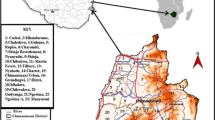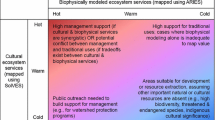Abstract
Invasive conifers have the potential to substantially alter natural, cultural, and heritage landscapes in many regions. While much work has been done to understand the impacts of biological invasions on ecosystem services such as water regulation and carbon sequestration, less is known about their impact on sites that have significant cultural value. Assessing these values is complicated by the fact that biological invasions are novel in nature. People are unlikely to have experience with the scales and types of change that concern researchers, meaning that it can be difficult to assess how these changes may impact both the way that people value places and also the specific sites that people value. We assess cultural values in the context of wilding conifers in three landscapes in New Zealand. We mix interview and survey data with scientific projections and visualisation tools based on spatial analysis to explore the interactions between the information that people have about invasives and the impacts that they have on cultural values. We find that concern about wilding conifers increases significantly when people are presented with visual, scientifically credible, projections of incursion. This change demonstrates the importance of communicating credible scenarios for biological invasions when considering how they might affect people’s cultural values.







Similar content being viewed by others
Notes
The NZ Wilding Conifer Management Group was established in the early 2000’s as a stakeholder oversight group for a research programme on South Island wilding conifers. It grew to take on a wider national level advocacy and advisory role. It is comprised of organisations and individuals interested in wilding conifer management and research. In 2016 a Wilding Conifer Control programme was funded by the NZ government. A revised leadership group has emerged now named the NZ Wilding Conifer Group. For more information about this group see https://www.wildingconifers.org.nz/about-us/programme-partners-structure-and-delivery/ (last retrieved January 2020).
We do not go into detail of the workshop in this paper as we did not seek permission to publish the proceedings, rather a Chatham House Rules approach was taken. The workshop supported free and frank discussion across participants active in each case study region plus central and local government policy and technical advisors. Insights gained from the workshop informed development of the 2016 Wilding Conifer Control Programme.
For further details about the location of each respondent please refer to Table 2, page 18 in the original study report Greenaway et al. (2015).
The six per cent rate of incursion was estimated based on unpublished data by Clayson Howell (Department of Conservation) and from a wilding conifer model (Scion, Ministry for Primary Industries, Contract No. 17234). The six per cent incursion rate was adopted for the interview exercise because it was considered more recent and more accurate than the five per cent estimate used in the earlier surveys.
References
Carr A (2008) Cultural landscape values as a heritage tourism resource. In: Prideaux B, Timothy D, Chon K (eds) Cultural and heritage tourism in Asia and the Pacific. Routledge, Oxfords
Chan K, Guerry A, Balvanera P, Klain S, Satterfield T, Basurto X, Bostrom A, Chuenpagdee R, Gould R, Halpern B, Hannahs N, Levine J, Norton B, Ruckelshaus M, Russell R, Tam J, Woodside U (2012a) Where are cultural and social in ecosystem services? A framework for constructive engagement. Bioscience 62:744–756
Chan K, Satterfield T, Goldstein J (2012b) Rethinking ecosystem services to better address and navigate cultural values. Ecol Econ 74:8–18
Church A, Fish R, Haines-Young R, Mourato S, Tratalos J, Stapleton L, Willis C, Coates P, Gibbons S, Leyshon C, Potschin M, Ravenscroft N, Sanchis-Guarner R, Winter M, Kenter J (2014) UK National Ecosystem Assessment follow-on. Work package report 5: cultural ecosystem services and indicators. Cambridge, UK: UNEP World Conservation Monotoring Centre
Cloke P, Perkins H (2002) Commodification and adventure in New Zealand tourism. Curr Issues Tour 5:521–549
Cosgrove D (1984) Social formation and symbolic landscape. Barnes and Noble, Totowa
Davis KT, Maxwell BD, Caplat P, Pauchard A, Nuñez MA (2019) Simulation model suggests that fire promotes lodgepole pine (Pinus contorta) invasion in Patagonia. Biol Invasions. https://doi.org/10.1007/s10530-019-01975-1
de Groot RS, Wilson MA, Boumans RMJ (2002) A typology for the classification, description and valuation of ecosystem functions, goods and services. Ecol Econ 41:393–408
Dechoum MDS, Giehl ELH, Sühs RB, Silveira TCL, Ziller SR (2019) Citizen engagement in the management of non-native invasive pines: does it make a difference? Biol Invasions 21:175–188
Díaz S, Pascual U, Stenseke M, Martín-López B, Watson RT, Molnár Z, Hill R, Chan KMA, Baste IA, Brauman KA, Polasky S, Church A, Lonsdale M, Larigauderie A, Leadley PW, van Oudenhoven APE, van der Plaat F, Schröter M, Lavorel S, Aumeeruddy-Thomas Y, Bukvareva E, Davies K, Demissew S, Erpul G, Failler P, Guerra CA, Hewitt CL, Keune H, Lindley S, Shirayama Y (2018) Assessing nature’s contributions to people. Science 359:270–272
DOC (2019) Wilding trees in Mackenzie/Waitaki [Online]. https://www.doc.govt.nz/our-work/wilding-trees-in-mackenzie-waitaki/: Department of Conservation. Accessed 14 Mar 2019
Egoz S, Bowring J, Perkins H (2001) Tastes in tension: form, function, and meaning in New Zealand’s farmed landscapes. Landsc Urban Plan 57:177–196
Estévez RA, Anderson CB, Pizarro JC, Burgman MA (2015) Clarifying values, risk perceptions, and attitudes to resolve or avoid social conflicts in invasive species management. Conserv Biol 29:19–30. https://doi.org/10.1111/cobi.12359
FAO (2005) International mechanisms for the control and responsible use of alien species in aquatic ecosystems. Report of an Ad Hoc Expert Consultation. Xishuangbanna, People’s Republic of China: FAO
Greenaway A, Samarasinghe O, Rees T, Bayne K, Velarde S, Heaphy M, Paul T, Kravchenko A (2015) Evaluating the (non-market) impacts of wilding conifers on cultural values. Landcare Research, Auckland
Howell CJ (2016) Recreating the invasion of exotic conifers in New Zealand. In: Australia, W. S. O. W. (ed) 20th Australasian weeds conference. Perth, Western Australia
IUCN (2013) Linking landscapes—exploring the relationships between world heritage cultural landscapes and IUCN protected areas. International Union for Conservation of Nature, Gland
Kaine G, Murdoch H, Lourey R, Bewsell D (2010) A framework for understanding individual response to regulation. Food Policy 35:531–537
Kaltenborn BP, Linnell JDC, Baggethun EG, Lindhjem H, Thomassen J, Chan KM (2017) Ecosystem services and cultural values as building blocks for ‘the good life’. A case study in the community of Røst, Lofoten Islands, Norway. Ecol Econ 140:166–176
Kirk N (2017) Understanding the impact of wilding conifer pines on cultural values (Policy Brief). Landcare Research, Auckland
Kueffer C, Kull C (2017) Non-native species and the aesthetics of nature. In: Vilà M, Hulme P (eds) Impact of biological invasions on ecosystem services. Springer, Switzerland
Lewis CL, Granek EF, Nielsen-Pincus M (2019) Assessing local attitudes and perceptions of non-native species to inform management of novel ecosystems. Biol Invasions 21:961–982
Lourey R, Kaine G, Davies A, Young J (2011) Landholder responses to incentives for wild dog control. Tatura, Australia: Department of Primary Industries
McInerny G, Chen M, Freeman R, Gavaghan D, Meyer M, Rowland F, Spiegelhalter D, Stefaner M, Tessarolo G, Hortal J (2014) Information visualisation for science and policy: engaging users and avoiding bias. Trends Ecol Evol 29(3):148–157. https://doi.org/10.1016/j.tree.2014.01.003->
Mertens DM (2014) Research and evaluation in education and psychology: integrating diversity with quantitative, qualitative, and mixed methods. SAGE Publications, Thousand Oak
Reid W, Mooney H, Cropper A, Capistrano D, Carpenter S, Chopra K, Dasgupta P, Dietz T, Duraiappah A, Hassan R, Kasperson R, Leemans R, May R, Mcmichael A, Pingali P, Samper C, Scholes R, Watson R, Zakri AH, Zurek M (2005) Millenium Ecosystem Assessment Synthesis Report
Mitchell R, Chitanava S, Dbar R, Kramarets V, Lehtijärvi A, Matchutadze I, Mamadashvili G, Matsiakh I, Nacambo S, Papazova-Anakieva I, Sathyapala S, Tuniyev B, Vétek G, Zukhbaia M, Kenis M (2018) Identifying the ecological and societal consequences of a decline in Buxus forests in Europe and the Caucasus. Biol Invasions 20:3605–3620
Monroe MC, Adams AE, Greenaway A (2019) Considering research paradigms in environmental education. Environ Educ Res 25(3):309–313. https://doi.org/10.1080/13504622.2019.1610863
Morgan DL (2014) Pragmatism as a paradigm for social research. Qual Inquiry 20(8):1045–1053. https://doi.org/10.1177/1077800413513733
New Zealand Wilding Conifer Management Group (2014) The right tree in the right place. New Zealand Wilding Conifer Management Strategy 2015–2030. http://www.wildingconifers.org.nz/. Accessed 22 Apr 2019
Novoa A, Dehnen-Schmutz K, Fried J, Vimercati G (2017) Does public awareness increase support for invasive species management? Promising evidence across taxa and landscape types. Biol Invasions 19:3691–3705
Office of Treaty Settlements (2004) Deed of settlement of the Te Arawa Lakes. Historical claims and remaining annuity issues. Te Arawa and Arawa Māori Trust Board and Her Majesty the Queen in right of New Zealand. In: Settlements, O. O. T. (ed) Wellington
Reeves K, McConville C (2011) Cultural landscape and goldfield heritage: towards a land management framework for the historic south-west pacific gold mining landscapes. Landsc Res 36:191–207
Sage E (2019) Visitors to Aoraki/Mt Cook exceed 1 million. Government Press Release. https://www.doc.govt.nz/news/media-releases/2019/visitors-to-aorakimt-cook-exceed-1-million/. Retreived Jan 2020
Shackleton RT, Richardson DM, Shackleton CM, Bennet B, Crowley S, DehnenSchmutz K, Estévez R, Fisher A, Kueffer C, Kull CA, Marchante E, Novoa A, Potgieter LJ, Vaas J, Vaz AS, Larson BMH (2019) Explaining people’s perceptions of invasive alien species: a conceptual framework. J Environ Manag 229:10–26. https://doi.org/10.1016/j.jenvman.2018.04.045
TE AO MARAMA INC (2007) Cultural values report on the proposed plan change Kingston Village prepared for Queenstown Lakes District Council. [Online]. http://www.qldc.govt.nz/assets/OldImages/Files/District_Plan_Changes/Plan_Change_25_downloads/Section_32_Report_and_Attachments/PC_25_Te_Ao_Marama_Report.pdf. Accessed 1st June 2015
TE URU RĀKAU (2019) Forestry in New Zealand [Online]. https://www.mpi.govt.nz/news-and-resources/open-data-and-forecasting/forestry/. Accessed 20 Apr 2019
UNESCO (2017) Operational guidelines for the implementation of the world heritage convention. United Nations Educational, Scientific and Cultural Organisation, Paris
Van Wilgen BW (2012) Evidence, perceptions, and trade-offs associated with invasive alien plant control in the Table Mountain National Park, South Africa. Ecol Soc. https://doi.org/10.5751/ES-04590-170223
Vaz AS, Kueffer C, Kull CA (2017) Integrating ecosystem services and disservices: insights from plant invasions. Ecosyst Serv 23:94–107. https://doi.org/10.1016/j.ecoser.2016.11.017
Vilà M, Hulme P (2017) Impact of biological invasions on ecosystem services. Springer, Switzerland
Vilà M, Gallardo B, Preda C, García-Berthou E, Essl F, Kenis M, Roy HE, González-Moreno P (2019) A review of impact assessment protocols of non-native plants. Biol Invasions 21:709–723
Williams D (2019a) Opposition builds against eco-tourism project. Newsroom.co.nz. https://www.newsroom.co.nz/2019/01/28/417635/opposition-builds-against-eco-tourism-project. Retrieved Jan 2020
Williams D (2019b) Court to rule on $100 m Mackenzie dairy conversion. newsroom.co.nz. https://www.newsroom.co.nz/2019/02/02/420193/court-to-rule-on-mackenzie-dairy-conversion. Retieved Jan 2020
Woods M (2011) The local politics of the global countryside: boosterism, aspirational ruralism and the contested reconstitution of Queenstown, New Zealand. GeoJournal 76:365–381
Zaichkowsky JL (1985) Measuring the involvement construct*. J Consum Res 12:341–352
Acknowledgements
The authors would like to thank Sarah Orton and Maria Heaphy (Scion Research) for their contributions to the background research for this paper, and Pike Brown for reviewing the manuscript. We also acknowledge the New Zealand Department of Conservation for funding the original research and MBIE for additional funding to write this paper through the Winning against Wildings programme.
Author information
Authors and Affiliations
Corresponding author
Additional information
Publisher's Note
Springer Nature remains neutral with regard to jurisdictional claims in published maps and institutional affiliations.
Rights and permissions
About this article
Cite this article
Gawith, D., Greenaway, A., Samarasinghe, O. et al. Socio-ecological mapping generates public understanding of wilding conifer incursion. Biol Invasions 22, 3031–3049 (2020). https://doi.org/10.1007/s10530-020-02309-2
Received:
Accepted:
Published:
Issue Date:
DOI: https://doi.org/10.1007/s10530-020-02309-2




